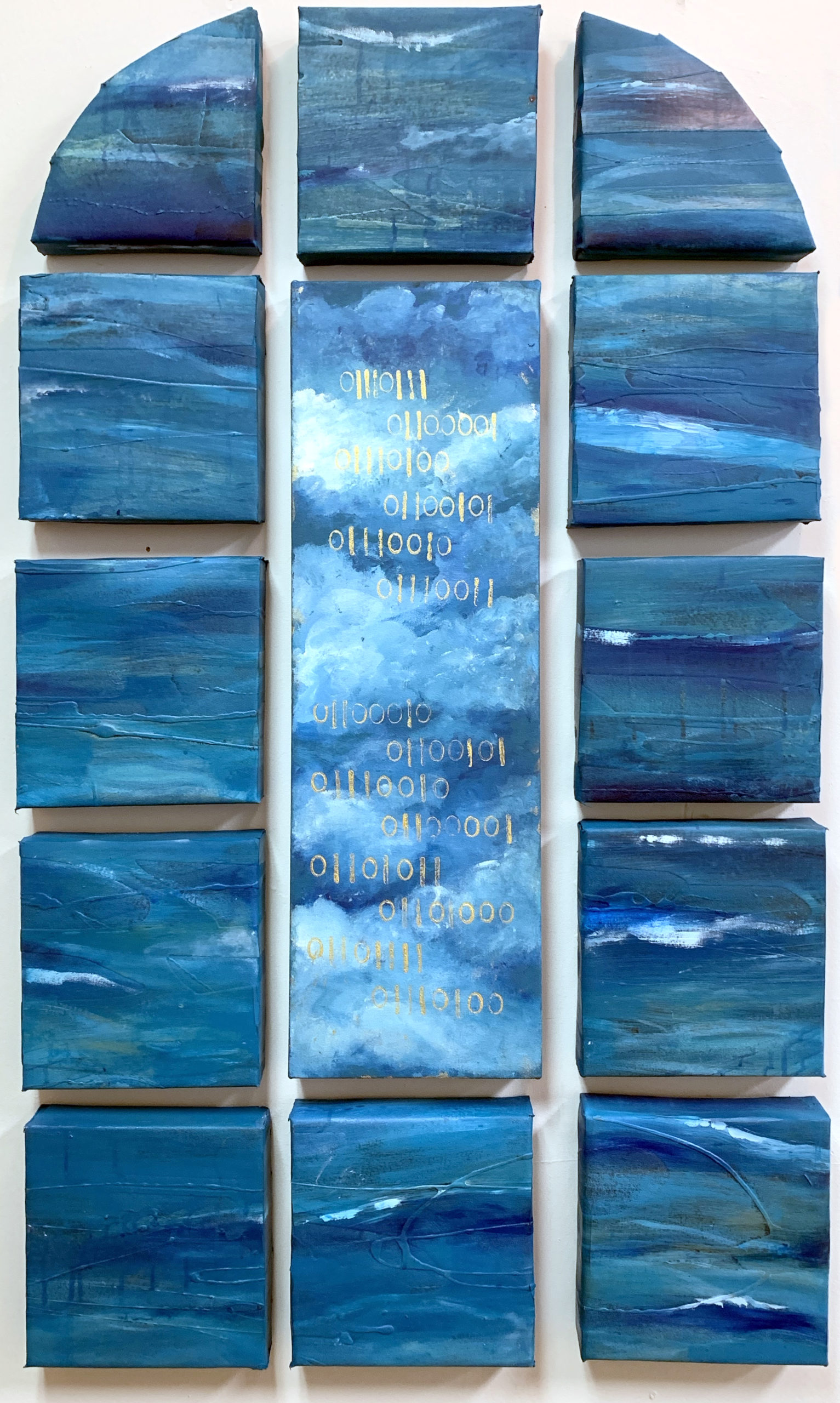Artist bio
Title
Waters
Medium/Genre
Mixed MediaArtist Statement
Waters
Water and clouds are symbols for me, of God's unchanging, yet everchanging eternal. Gold represents purity, perfection, knowledge, wisdom and beauty - but what is described with the gold paint? Binary code. The binary code in this particular painting is translatable as "waters," and "berakhot," a word meaning blessing in Hebrew. The word also contains with it the idea of everyday objects pointing to God. In our culture, we are fast substituting binary coding applications for truth, beauty, perfection and knowledge, and are becoming unable to perceive the beauty of God's creation around us. The number twelve in this piece represents perfection. Thirteen is a number of imperfection and incompleteness; it is symbolic of the way that we as humans have distorted and changed the original perfection of God's creation and continue to do so today. The acrylic paint and mixed media all point to fakeness and our inability to re-create (or create for that matter) anything that God has made. I can try to depict the beauty of waves, for instance, and may even give you a glimpse of it, but it will never be the actual ocean, it is at best, mimesis. We have distorted it further by attempting to view it through the lens of the digital and thereby miss the actual beauty and meaning of the real thing. The structure of the work mimics the form of the arch and stained glass in a Gothic cathedral, a place designed specifically for worship, every aspect pointing to God. We have unfortunately made technology our god in this culture. We are used to seeing the pointed arch as an element of architecture that enabled buildings to reach higher into the heavens. The lack of architectural buttressing in this piece is intended to elicit a feeling of uneasiness and eternity.
A poem written to go with this work:
A willful hope
take joy in what is
the beauty of the cloud
the waters, the grass, the tree
strong and towering
a sure resurrection
a powerful peace
a presence all around
a will-filled hope
I choose it.
How it fits into contest
Using a kinesthetic approach to painting, both of these works are tactile and have obvious references to my own hand in their making. This work is my way of expressing disdain for our current conceptions of what it means to be human.
Transhumanism instead of making us more than human, is actually making us less than human. It is destroying how we perceive what God has made all around us, including people. Thinking that we can improve upon humanity, we are instead destroying it. Binary causes the perception of God's blessings to be occluded and undiscernible. We use our cell phones, tablets and computers to display images of the natural world, all the while assuming that it accurately reflects it. Binary and its resulting pixels distort, simplify and conceal the most important concepts: grace and beauty. We have begun to accept a counterfeit substitute for the real thing. Peering through our technology, we see only a false appearance of beauty and miss the real, tangible, truth of the beauty that surrounds us every day. It is also incredibly impermanent - as changeable as the wind and far more subject to change and self-deception. What is the real appearance of things found in my photographs, when I can change everything to be what I want it to be in Photoshop, Gimp or other software programs?
I believe we are haters of ourselves to such an extent that we cannot deal with our own limitations as human beings and easily accept technology as a way to become more than who we were made to be; but in doing so, the opposite becomes our reality.
Transhumanism also seeks to place human beings into the form of god-likeness. Through technology, psychology, pharmacology and other scientific means, we are trying to make ourselves into beings that transcend how we are made biologically (with no human interference). Thus the perspective with which we view reality is in constant flux and changes because of all of the heterogenous ways that we are becoming able to view it. The danger is that we are setting ourselves up against God Himself and His sovereignty as our Creator/Maker. Each stroke of the philosopher's pen has taken humanity further from our origins and purpose in God's great design.
The binary code conveys a sense of naturalism and a rejection of academic art theory, contrasted with the very rigid grid-like structure that conveys everything academia considers worthwhile. It also speaks to our inability to see the future – a mode of remembering that may not exist in years to come – we may lose much because of the impermanence of digital technology. The binary code in this particular painting is translatable as "waters" and the lower part, "berakhot," a word meaning blessing in Hebrew. The word also pointing to the idea of everyday objects leading us to a greater knowledge and appreciation of God
How to Purchase this Artwork
$1200
Contact the artist at cnadaska@uu.edu.
View more art from around the world
Submit Your Artwork Today!
Curious? Interested in submitting artwork to our contest? Know someone who might be? Through April 14th, 2022, the Engage Art Contest is open to the whole world! Get your foot in the door by claiming your Artist Page now!



